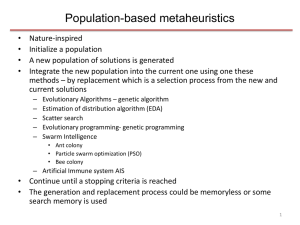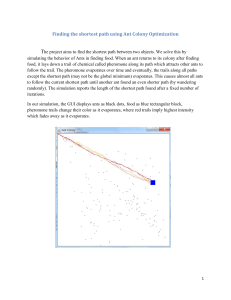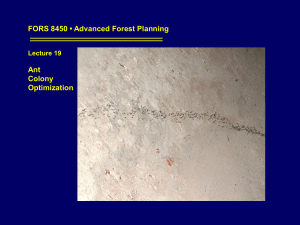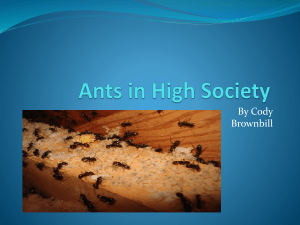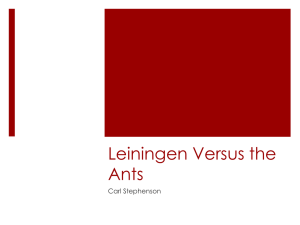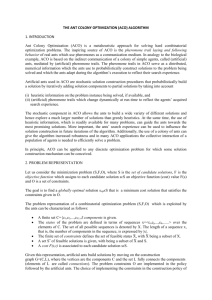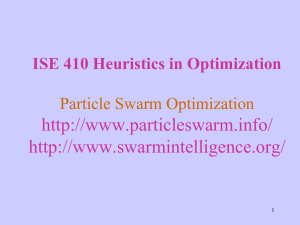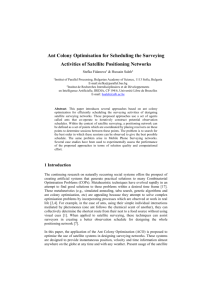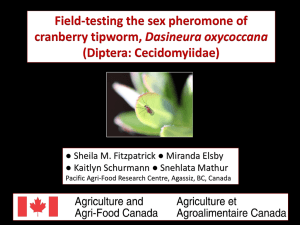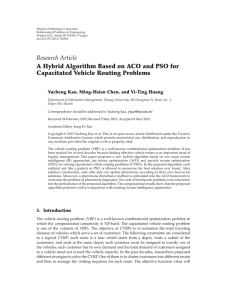Shape Analysis in Time Series - Computer Science and Engineering
advertisement
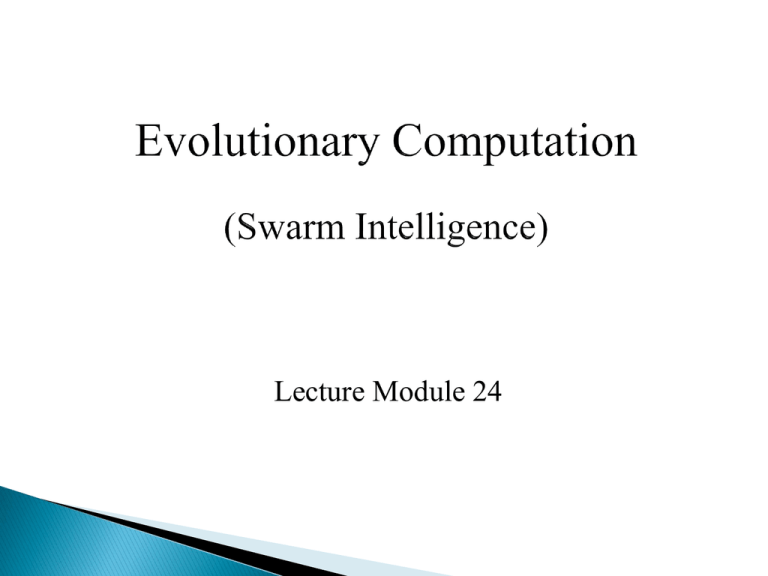
Lecture Module 24
• Swarm describes a behaviour of an
aggregate of animals of similar size and
body orientation.
• Swarm intelligence is based on the
collective behavior of a group of
animals.
• Collective intelligence emerges via
grouping and communication, resulting
in successful foraging (the act of
searching for food and provisions) for
individual in the group.
• Examples : Bees, ants, termites, fishes,
birds etc
•
•
•
•
Marching of ants in an army
Birds flocking in high skies
Fish school in deep waters
Foraging activity of micro-organisms
• In the context of AI, SI systems are
• based on collective behavior of decentralized, self-organized
systems.
• typically made up of a population of simple agents interacting with
one another locally and with their environment causing coherent
functional global pattern to emerge.
• distributed problem solving model without centralized control.
• Even with no centralized control structure dictating how
individual agents should behave, local interactions between
agents lead to the emergence of complex global behavior.
• Swarms are powerful which can achieve things which no single
individual could do.
• Adaptability
Self-organizing
• Robustness
Ability to find a new solution if the current solution
becomes invalid
• Reliability
Agents can be added or removed without disturbing
behaviour of the total system because of the distributed
nature
• Simplicity
• No central control
• ANT COLONY OPTIMIZATION (ACO)
Invented by Marco Dorigo in 1991.
Inspired by behaviour of ants.
Real ants lay down pheromones directing other ants to
resources while exploring their environment.
Used extensively for discrete optimization problems.
• PARTICLE SWARM OPTIMIZATION (PSO)
Population based stochastic optimization technique
developed by Eberhart and Kennedy in 1995.
Inspired by social behaviour of flocks of birds and school of
fish
• A set of agents (similar to ants), search in parallel for good
•
•
•
•
solutions and co-operate through the pheromone-mediated
indirect method of communication.
They belong to a class of meta-heuristics.
These systems started with their use in the Traveling
Salesman Problem (TSP).
They have applications to practical problems faced in
business and industrial environments.
The evolution of computational paradigm for an ant colony
intelligent system (ACIS) is being used as an intelligent tool
to help researchers solve many problems in areas of science and
technology.
• Biological Ant Colony Systems
Organizing highways to and from their foraging sites by leaving
pheromone trails.
Form chains from their own bodies to create a bridge to pull and
hold food together.
Division of labour between major and minor ants.
• How do real ants find the shortest path?
Ants can smell pheromones, they tend to choose the
paths marked by strong pheromone concentrations.
The emergence of shortest paths can be explained by
Autocatalysis : positive feedback
Differential path length
Communication is indirect through pheromones.
Ants indirectly influence other ants to follow the path
(Recruitment)
• Similarities
A colony of cooperating individuals
An artificial pheromone trail for communication
A sequence of local moves for finding the shortest paths
A stochastic decision policy using local information and no
look ahead
• Differences
Ant moves are discrete,
Ants have an internal state having memory of past actions
Ants can deposit a particular amount of pheromone at certain
time instances which may not reflect real behaviour
Enrichment with other techniques like backtracking, etc
• Working involves two procedures
Specifying how ants construct or modify a solution
for the problem in hand.
Done
in a probabilistic way based on problem dependent
heuristics and amount of pheromone previously
deposited in this trail.
Updating the pheromone trail.
• Let kth ant (denoted by antk) is located at the ith node
and ptij is intensity of pheromone trail on the Arc(i, j).
• The probability of moving antk located in ith node to
jth node is defined as follows:
probij(k) = ptij / ptim , m Neighour set of i
• In simple ACO algorithm, constant amount of pheromone is
deposited by ants.
• The pheromone updation at time ‘t’ from ith node to jth node is
defined as follows
ptij (t) = ptij(t) +
• This increases the probability of the arc that can be used by
other ants in future.
• Alternatively at the end of each cycle (or route), the intensity
of pheromone trails on each arc is updated by the following
pheromone updating rule
ptij = ptij + ptij(k), k = 1 to m
where ρ (0,1) is the persistence rate of previous trails, ptij(k)
is the amount of pheromone laid on Arc(i, j) by the antk at the
current cycle, and m is the number of distributed ants.
• To avoid quick convergence of all the ants towards sub
optimal path, an exploration mechanism is added.
• It is similar to pheromone trail evaporation in real scenario.
• It is carried out by decreasing pheromone trail in each iteration
of algorithm using the following factor.
= (1 - )* , (0, 1)
• This decrease can be done in various ways, such as:
• While moving from ith node to jth node, ant can update pheromone trail
ptij on the Arc(i, j).
• Once the solution is built, the ant can retrace the same path and update
pheromone trail of the each arc on the path.
• Pheromone trail can be updated offline using global information.
•
•
•
•
•
•
•
•
•
•
•
Traveling Salesman Problem
Quadratic assignment
Job shop scheduling
Vehicle routing
Sequential ordering
Graph colouring
Network routing
Flow manufacturing
Layout of facilities
Space planning
Numeric optimization
Traveling Salesman
Problem
◦ Hard combinatorial
problem
◦ Because of suitability
and flexibility, ant
intelligence is used.
◦ Assume that there are
‘n’ cities.
◦ Let ‘m’ be total number
of ants used for solving
the problem.
● Distribute ‘m’ ants randomly / uniformly amongst
different cities at time t = 0.
● Initialize ptij(0) = C, a small positive constant.
● SetTabu list of each ant with its starting (assigned) state.
Repeat
Iterate the following ‘n’ times for one cycle.
• Move each ant at time t+1 from the current state to next state
according to probabilistic rule.
• Update the Tabu list for this particular cycle.
Once the cycle is complete, save the minimum distance
covered among all the tour distances by all ants for that
particular cycle.
After each complete tour, update the pheromone trail.
Until there is no improvement in the shortest tour saved.
● Display the shortest path
• Originated with the idea to simulate the unpredictable
choreography of a bird flock with
Nearest-neighbour velocity matching
Multi-dimensional search
Acceleration by distance
Elimination of ancillary variables
• Advantages
Simple
Few parameters
Easy to implement
Robust
Searches a much larger portion of the problem space
• PSO shares many similarities with Genetic Algorithms (GA).
• The system is initialized with a population of random
solutions (called particles) and searches for optima by
updating generations.
• Each particle is assigned a randomized velocity.
• Particles fly around in a multidimensional search space or
problem space by following the current optimum particles.
• However, unlike GA, PSO has no evolution operators such as
crossover and mutation.
• Compared to GA, the advantages of PSO are that it is easy to
implement and there are few parameters to adjust.
• Each particle adjusts its position according to
• its own experience,
• the experience of a neighboring particle
• Particle keeps track of its co-ordinates in the problem space
which are associated with the best solution/ fitness achieved so
far along with the fitness value (pbest partcle best).
• Overall best value obtained so far is also tracked by the global
version of the particle optimizer along with its location (gbest).
• Two versions (according to acceleration)
• Global
• At each time step, the particle changes its velocity (accelerates) and
moves towards its pbest and gbest.
• Local
• In addition to pbest, each particle also keeps track of the best
solution (lbest/nbest – neighbour best) attained within a local
topological neighbourhood of the particle.
• The acceleration thus depends on pbest, lbest, and gbest.
The particle position and velocity update equations in
the simplest form that govern the PSO are given by
Let f be a fitness function that takes a particle
(solution) with several components in higher
dimensional space and maps it to a single dimension
metric as f :Rm R.
Assume that there are n particles, each with
associated positions xi Rm and velocities vi Rm ,
i = 1,…, n.
◦ Let Xi be the current best position of each particle,
◦ NXi be the current best position of its neighbours, and
◦ G be the global best.
initialize xi and vi i.;
Do the following assignments:
Xi xi, NXi Best of Neighbours(xi) and G best
fitness value (f(xi)) I;
repeat
{ for each particle
create random vectors R1, R2, and R3 containing
components having a uniform random number between 0
and 1;
update the particle positions xi as xi xi + vi;
update the particle velocities as
vi ωvi + c1R1 (Xi – xi) + c2R2 (NXi – xi) + c3R3 (G – xi),
where, ω is an inertial constant and usually good values are slightly
less than 1; c1, c2 and c3 are constants indicating how much the
particle is directed towards good positions; operator indicates
vector multiplication;
update the local bests
Xi xi, if f(xi) < f(Xi);
update the neighbour’s best
NXi Best of Neighbours(xi);
update the global best
G xi, if f(xi) < f(G);
} until convergence occurs;
report G to be the optimal solution;
Stop
• PSO has been successfully applied in many areas: function
optimization, artificial neural network training, fuzzy system
control, and other areas where GA can be applied.
• Important applications
Ingredient mix optimization
Reactive power and voltage control
Evolving neural networks
Optimization problems
Classification
Pattern recognition
Biological system modeling
Scheduling
Signal processing
Robotic applications
Decision making
Consider a normal solution sequence of TSP with n nodes S
=(ai), i=l ... n.
The Swap Operator SO(i1, i2) is defined as exchanging the
node at i1 and i2 position in solution S.
Then the new solution S' is defined as
S'=S+ SO(i1, i2),
The plus sign " + ' above has its new meaning.
For example: TSP problem with five nodes:
o Here is a solution:
S=(l, 3, 5, 2, 4).
o The Swap Operator is SO(1,2), then,
S'= S + SO(1, 2)= (1, 3, 5, 2, 4) + (1, 2) = (3, 1, 5, 2, 4).
A Swap Sequence SS is made up of one or more Swap
Operators.
◦ SS=(SO1, SO2, SO3, ..., SOn)
SO1, SO2, SO3, ..., SOn are Swap Operators, and the order
of the Swap Operators in SS is important.
Swap Sequence acting on a solution implies all the Swap
Operators of the Swap Sequence act on the solution in order.
This can be described by the following formula:
◦ S'= S + SS = S + (SO1, SO2, SO3, ..., SOn) = ((S+ SO1)+ SO2)+ ... +
SOn
• Agents are entrepreneurs and the cities are the resources
(productive inputs and market information) distributed in the
business environment.
• The ultimate goal is to find the shortest circular route
between all resources.
• Results
The initial journey indicates how unproductive an entirely random
search would be (entrepreneurs with no knowledge of their business
environment and no precedents to follow are ineffective).
Illustrates how the local self-organizing behaviour of individual
entrepreneurs can result in the emergence of a pattern of
entrepreneurial activity.
Also, the addition of more virtual entrepreneurs at first increases the
efficiency of the search. However, very large numbers of
entrepreneurs in the same environment do not.
Researchers from Hewlett-Packard’s laboratories in Bristol,
England, have developed a computer program based on antforaging principles that routes such calls efficiently.
Software agents roam through the telecom network and
leave bits of information (digital pheromone) to reinforce
paths through uncontested areas.
Phone calls then follow the trails left by the ant-like agents.
Digital pheromone continually evaporates, enabling the
program to adjust quickly to changes in traffic conditions.
Ultimate application might be on the Internet, where traffic
is painfully unpredictable: research results show
improvements in both maximizing throughput and
minimizing delays.
